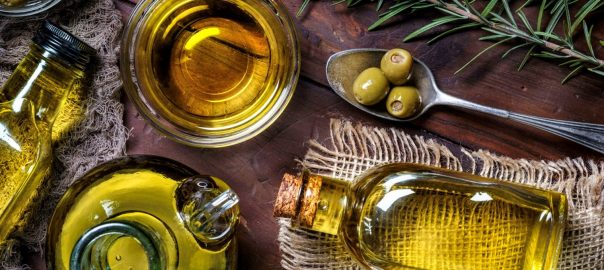
Best Cooking Oils (Health Perspective)
Buying the Top 5 Cooking Oils: Cooking Oils Showdown
Where to buy the best cooking oils to make the right choice for you and your skillet!
The type of oil you use to cook matters a lot, and making a major difference in your health could be as simple as swapping out your normal cooking oil for a better option. The right cooking oil will allow you to include more healthy fats in your meals and avoid consuming toxic compounds that result from cooking with oils that are unstable at high temperatures. It all comes down to chemistry. So, what may seem like a good option at surface level may fare quite differently when you add a little heat!
Disclaimer: The information in this article is not intended to replace personalized medical dietary advice. Always consult your health care provider before making any changes to your lifestyle or use this information at your own risk.
In this article, we cover all of the most common cooking oils and rank them from best to worst so that you can find the best cooking oil for you. If you discover that you have been using a cooking oil that isn’t the healthiest or safest option, don’t hesitate to swap it out immediately.
You can find some healthy cooking oils at The Low Carb Grocery – check out our inventory today!
#1 BEST: Coconut Oil
Coconut oil tops our list as the best oil to use in cooking! It is also great for baking and a number of other household uses – but that isn’t the only reason why it’s our number one.
Coconut oil is highly resistant to oxidation at high temperatures, meaning it is great for cooking on high heat and using certain cooking methods such as frying. It is, of course, safe to use at lower temperatures, as well. In addition, the fat content of coconut oil is very unique. While about 40% of the total fat in coconut oil is saturated fat, it is not the artery-clogging, cholesterol-raising type of saturated fat. It has been shown that the saturated fat found in coconut oil – unlike that found in butter, fatty cuts of meat, dairy and lard – does not raise levels of LDL (“bad”) cholesterol.
The medium-chain triglyceride (MCT) fats found in coconut oil may also be especially good for those on a low-carb high-fat or ketogenic diet. This is because they are quickly and easily converted into ketones – usable energy for the body – by the liver, rather than being stored. This encourages your body to burn fat more quickly, raise levels of HDL (“good”) cholesterol, and can help reduce the risk of related heart diseases.
When shopping for coconut oil, try to look for pure, organic virgin or extra virgin coconut oil. The term “virgin” means that the oil has undergone little or no processing (which may include bleaching, deodorizing and refining). Organic is the best option as this means that the coconuts have not been exposed to harmful farming chemicals – and neither will you! Pure coconut oil should have very little taste, although some people enjoy the slightly sweet, nutty taste of coconut oil.
We recommend Wild Tusker Organic Virgin Coconut Oil. A portion of all proceeds from Wild Tusker products are donated to the Pinnawala Elephant Orphanage to help save this endangered species.
#2: Extra Virgin Olive Oil
Coming in close second, extra virgin olive oil is another very healthy option! Olive oil is best used on low or medium heat, which is why it’s not our top pick. That said, olive oil still contains high levels of antioxidant compounds called polyphenols which help prevent oxidation at higher temperatures. When fat is oxidized, it breaks down into unstable molecules which can cause a lot of damage to cells inside the body. It can lead to inflammation which increases the risk of developing type 2 diabetes, cardiovascular disease, cancer, arthritis and bowel diseases such as Crohn’s. Extra virgin olive oil contains more polyphenols compared to regular olive oil since it is unrefined, so it’s always best to look for this on the labelling. Again, choose organic where possible. Also be sure to look for extra virgin olive oil that comes in a dark-stained glass bottle as this prevents further oxidation from sunlight.
In addition to being packed with antioxidants, extra virgin olive oil is also high in healthy monounsaturated fats (deemed the healthiest type of fat), as well as vitamins E and K, which can help prevent premature aging and cognitive decline, reduce the risk of heart disease and cancer, support immune function, and improve eye health. Did you know that people tend to live longer in places where olive oil is a staple part of the diet?
#3: Grass-Fed Butter or Ghee
Closing out our top 3 cooking oils, grass-fed butter or ghee are the healthiest types of animal fats you can use. Ghee is a form of highly clarified butter that is traditionally used in South Asian cooking. It is made by melting butter until it separates into its individual components, which allows the milk solids to then be removed. This means that ghee contains less lactose than butter, which could be a plus if you are sensitive to lactose/dairy.
If you choose butter instead of ghee, it is essential that you buy organic, grass-fed, pasture-raised butter (and ditch margarine altogether). Cows that are raised according to these standards are much healthier, meaning that their milk contains more vitamins, antioxidants and healthy fats. In particular, it is higher in omega-3 fatty acids, which help reduce inflammation unlike omega-6 counterparts that have been shown to produce inflammatory effects when consumed in excess. It is also worth mentioning that you should aim to eat a diet rich in omega-3s, with an ideal ratio of omega-6 to omega-3 fatty acids of 4:1 or less. It might surprise you to learn that the Western diet has a typical ratio of somewhere between 10:1 and 50:1! Consuming omega-6s at these levels is very dangerous to one’s health, and vegetable and seed oils are some of the worst culprits of poor omega 6 to omega 3 ratios. As we move down our list towards the worst cooking oils, you’ll see that the omega-6 contents skyrocket!
#4: Avocado Oil
Avocado oil is naturally high in healthy monounsaturated fats, vitamins and minerals. The monounsaturated fats found in avocado oil have also been shown to help the body absorb fat-soluble essential vitamins, boosting the overall nutritional value of your meal! While, overall, its nutrient profile is very similar to that of olive oil, one key distinction is that avocado oil contains less polyphenols, the oxidation-fighting chemicals that reduce inflammation in the body. Extra virgin olive oil also contains slightly more vitamin E, which provides more benefits for the skin, eyes and brain.
Although avocado oil has a higher smoke point than olive oil, due to its lower amounts of polyphenols, it tends to oxidize more than olive oil. When comparing the omega-6 to omega-3 fatty acid ratio of avocado oil, it also falls slightly behind our better rated oils. Avocado oil has a ratio of 13:1, while extra virgin olive oil has a ratio of 8:1 and ghee has a ratio of 1.5:1 (coconut oil also has negligible amounts of both <4:1).
Once again, it is best to look for unrefined avocado oil to avoid harmful processing such as bleaching and deodorizing. Be aware that avocado oil also tends to come with a much higher price tag than other oils. In addition, it can impart a certain flavour that not all people enjoy.
#5: Macadamia or Peanut Oil
Macadamia nut and peanut oil are both naturally trans-fat free, cholesterol free and low in saturated fats. They are also high in monounsaturated fats, like those found in the previous healthy cooking oils.
Macadamia nut oil has a smooth, buttery flavour, making it good for roasting, baking and deep frying due to its high smoke point. In addition, 80-85% of the fat content in macadamia nuts comes from healthy monounsaturated fats! These have been shown to help lower bad cholesterol levels and promote fat-burning rather than fat-storing. Macadamia nut oil is one of the more stable nut oils when exposed to heat and contains a good amount of antioxidants that can help prevent some oxidation. That said, it is probably best used in low heat cooking or in salad dressings.
Find Organic Macadamia Oil here.
Peanut oil has a very high smoke point, which is why it is often used for frying and high heat Asian cooking methods. That said, it does unfortunately contain high amounts of omega-6 fatty acids, making it prone to oxidation despite its high smoke point. A high smoke point simply indicates that you won’t get the bitter taste from food that has been cooked in smoke. As such, peanut oil is not a very safe choice of cooking oil, but if you choose to use it for its unique flavour, try to find one that is cold-pressed and unrefined.
Note that any oils beyond this point in our list should ideally be avoided. Learn why the following oils should not be used in cooking, and how they could be harming your health.
#6: Soybean Oil
Soybean oil is also high in inflammatory omega-6 fatty acids, although it does contain mostly unsaturated fats, which are better for heart health compared to traditional saturated fats. One of the main problems with soybean oil is that it tends to be partially or fully hydrogenated, a term used to describe food processing that strips many of the original nutrients from the oil. Hydrogenated oils are some of the worst oils to consume because they increase levels of bad cholesterol and lower good cholesterol levels, and that poses many risks to heart health. Some research has also linked soybean oil to obesity and diabetes. This could be due to the fact that soybean oil is found in many mass-produced, packaged foods since it is a relatively cheap oil.
Just because soybean oil is not a great choice for cooking doesn’t mean that you should throw out your soy sauce, tofu, edamame or soymilk! These foods contain only small amounts of soybean oil and provide lots of other healthy nutrients and plant-powered protein.
#7: Canola Oil (AKA Rapeseed Oil)
The debate surrounding canola oil is quite confusing – some claim that it’s terrible, while others claim it’s perfectly safe for consumption.
Canola oil gained its popularity when health experts began to advise against consuming saturated fats. Given its low saturated fat content, many people deemed canola oil a “healthy option” without taking into account other factors that make for a healthy cooking oil. Canola oil is often used in food manufacturing since it has little to no flavour, so it can be used in a variety of recipes from sweet to savoury. What isn’t widely understood is that this lack of flavour is also partially due to the fact that most canola oil on the market is refined, bleached and deodorized. The refining process causes oxidation and replaces some of the healthier polyunsaturated fats found in canola oil with dreaded trans fats (the kind of fat that clogs your arteries). Another problem with canola oil is that it contains very high levels of erucic acid, which can be toxic to humans and animals. Frequent consumption has been linked to the formation of fat deposits in the heart. So, it’s safe to say that canola oil is not very safe for consumption!
#8: Corn Oil
Corn oil is another cheap and flavourless cooking oil that should be avoided. Given the fact that is it often highly refined, it is a very poor choice nutrition-wise. Corn must go through a very complex refining process in order to produce corn oil – which makes sense, since corn is not naturally a high-fat food like coconuts, olives or avocados. Unfortunately, this refining strips the nutrients present in corn and converts the fats into trans fats. In addition, the heat use to refine corn oil produces an antinutrient called acrylamide, which is a highly reactive compound that has been linked to an increased risk of cancer and poor nerve, muscle and hormone function. Note that other foods that typically undergo high-heat processing such as French fries, potato chips, crackers, cookies, cereals and roasted coffee beans are also likely to contain acrylamide.
Corn oil also has an omega-6 to omega-3 ratio of 46:1. Frequent consumption of high omega-6 and highly refined goods have been linked to obesity, impaired cognitive function, depression and heart disease. Furthermore, a lot of the corn grown in North America is genetically modified and non-organic.
#9: Sunflower Oil
Although sunflower seeds are packed with nutrients such as vitamins A and E, folate and choline, sunflower oil differs vastly in its nutrient content. Sunflower oil is not extracted from the same seeds you might find in a grocery snack aisle, and it often undergoes intense processing. Cold-pressed unrefined sunflower oil may be used for salad dressings and sauces; however, it is more common to find bleached, chemically extracted sunflower oil in processed foods. Refined sunflower oil is stripped of most of the vitamins and polyphenols naturally found in sunflower seeds. This lack of antioxidants means that sunflower oil is easily oxidized when exposed to heat. This can damage cell DNA and lead to obesity, cancer and a host of other health conditions.
Sunflower oil also has a very high ratio of omega-6 to omega-3 fatty acids – around 300:1! This definitely makes it a poor choice if you are trying to limit your intake of omega-6 fatty acids, which we all should be! It is also much lower in healthy monounsaturated fats compared to the other oils ranked above it, meaning that there are healthier options out there if you are looking to consume more healthy fats in your diet. It should also never be used in cooking because it releases toxic compounds when heated at high temperatures.
#10 WORST: Grapeseed Oil
Grapeseed oil has an omega-6 to omega-3 ratio of about 700:1 – yes, you read that right! This is why it has earned the spot of worst cooking oil on our list. Remember, you should aim to consume an omega-6 to omega-3 ratio of 4:1 or less, so grapeseed oil should already be out of the question based on this fact alone!
Conclusion
After investigating many common cooking oils, we hope this list helps you understand what to look for and what not to look for in your cooking oils. Make sure to find an oil that is rich in omega-3 fatty acids – especially in comparison to its omega-6 fatty acid content – and that can withstand the temperatures you plan to cook at, without oxidizing. Our top 3 cooking oils are really your best bet in the kitchen, and anything else is safe to avoid.
Also, remember to be mindful of the oils used in packaged or cooked food from restaurants. Many restaurants use hydrogenated vegetable oils that are high in trans fats, simply because they have little flavour and don’t need to be changed as often out of the deep fryer. Always be sure to read the ingredients lists on packaged products and avoid anything labelled as “hydrogenated”, “partially-hydrogenated”, or “high-linoleic”. Stay safe and stay healthy!
Stay in the Loop!
We hope that you discovered something new about cooking oils and found the right cooking oil for you. If you would like to share your thoughts or experiences, head over to our Facebook and Instagram pages.
We also love to read our Google Reviews, so please share your experience with us over there! And lastly, remember to sign up for our Weekly Newsletters for updates on the latest products and sales!






